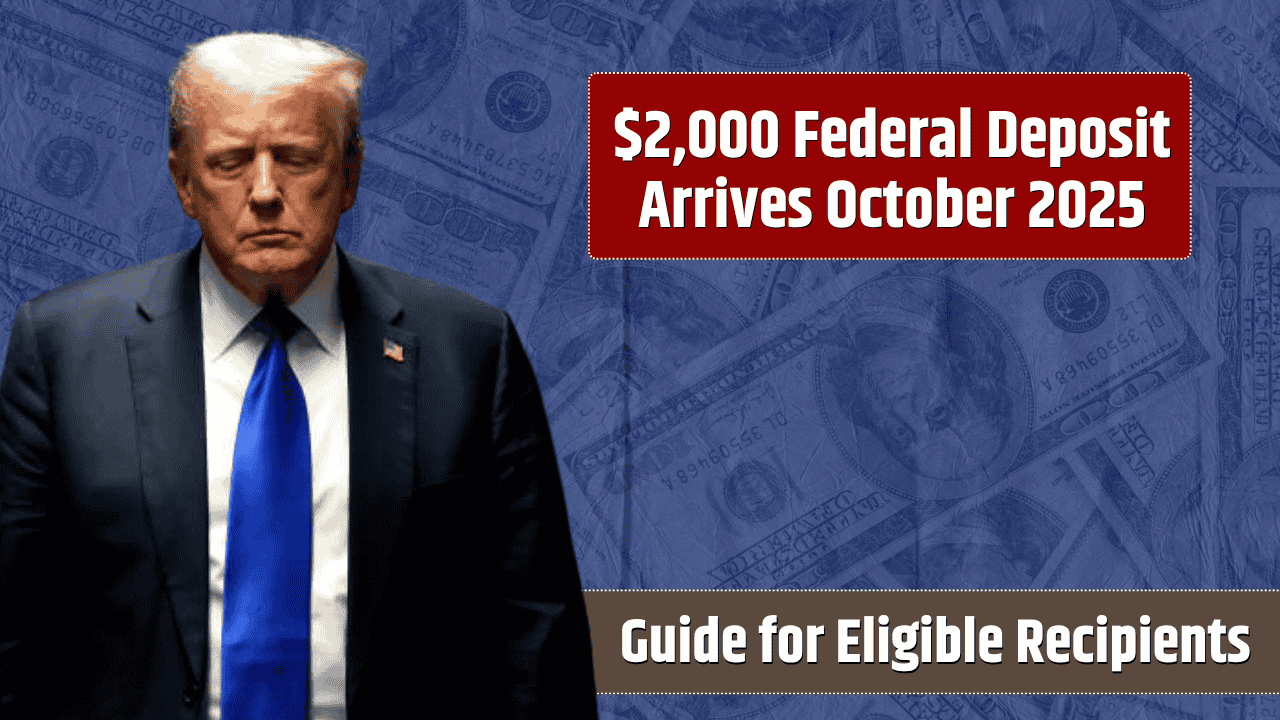$2,000 Federal Direct Deposit Arriving October 2025:- By mid-October, a wave of direct deposits will quietly start landing in American bank accounts — $2,000 apiece for millions of qualifying taxpayers. It’s not another stimulus check in the classic sense, but it might feel like one. The U.S. Treasury and IRS have confirmed the rollout of a one-time federal relief payment, designed to offset stubborn inflation and ease cost-of-living pressures heading into the final stretch of 2025.
A new round of relief — with strings attached
This payout stems from the Federal Inflation Adjustment Initiative, a targeted economic measure approved earlier this year to support low- and middle-income earners. Officials at the U.S. Department of the Treasury and Internal Revenue Service (IRS) say the program focuses on those hit hardest by rising rent, healthcare bills, and grocery costs.
But unlike the pandemic-era stimulus checks, you don’t have to sign up for anything. If you filed your 2024 tax return, the IRS already has the information it needs. The payments are being calculated automatically, based on your income and filing status, and will flow through the same channels used for your most recent tax refund.
According to an IRS distribution bulletin published earlier this month on irs.gov, direct deposits began on October 15, 2025, and will continue in rolling batches through October 25. Paper checks and debit cards will follow in early November for those without direct deposit.
Who qualifies and how much you’ll get
Here’s how eligibility shakes out.
| Filing Status | Income Limit for Full $2,000 | Phase-Out Range | No Payment Above |
|---|---|---|---|
| Single | ≤ $70,000 | $70,001–$100,000 | $100,000+ |
| Married Filing Jointly | ≤ $150,000 | $150,001–$200,000 | $200,000+ |
| Head of Household | ≤ $112,500 | $112,501–$150,000 | $150,000+ |
As with previous federal relief programs, payments taper off as income rises. The IRS says reductions will follow a “gradual phase-out formula,” meaning partial payments for those near the upper thresholds.
Eligibility also requires a valid Social Security number, U.S. citizenship or lawful residency, and a 2024 tax filing showing earned income within those ranges.
How to track your payment $2,000 Federal Direct Deposit Arriving October 2025
Once processing begins, taxpayers can monitor the payment’s progress using the IRS’s online tools:
- Get My Payment – Shows whether your deposit has been issued, pending, or scheduled.
- Where’s My Refund? – Updated to reflect status for relief payments tied to 2024 returns.
Both platforms require basic verification — SSN or ITIN, filing status, and refund amount — and refresh daily.
If you haven’t received your payment by mid-November 2025, you’ll be able to claim it as a Recovery Rebate Credit on your 2025 tax return, a process similar to pandemic stimulus adjustments.
Why another round now?
Economists inside the Federal Reserve and Treasury have been warning for months that while inflation has cooled from its 2022 peaks, essential categories — food, rent, energy, healthcare — remain elevated. The Federal Inflation Adjustment Initiative, quietly inserted into the latest budget reconciliation framework, aims to provide a “bridge payment” to offset those costs.
A Treasury spokesperson described it as “a practical cushion, not a long-term fix.” Think of it as the government buying households some breathing room while wages catch up to price levels.
What $2,000 means right now
Let’s be real — $2,000 isn’t life-changing money, but it’s significant. For many families, it could cover a month of rent, a couple of grocery runs, or the winter utility bill. For retirees or single parents, it’s the difference between paying off a medical balance and rolling it into next year’s debt.
Psychologically, there’s something bigger at play too. After years of pandemic whiplash, volatile markets, and political wrangling, a direct deposit that just shows up feels reassuring — proof that the federal system can still deliver without endless paperwork or confusion.
What to do now
The IRS recommends taking a few quick steps before your payment date:
- Verify your direct deposit info on your most recent tax filing or IRS online account.
- Update your mailing address if you’ve moved since filing your 2024 return.
- Check your tax transcript to ensure no pending offsets (like back taxes or federal debts) that might reduce the amount.
- Keep an eye on your bank notifications between October 15–25 for deposits labeled “U.S. Treasury 310 TAX REF.”
If your banking details changed recently, it’s too late to update them for this round — the IRS will mail a paper check instead.
Broader impact — and skepticism
Economists are divided on whether this measure truly tackles inflation pain or merely masks it temporarily. Some critics argue it risks nudging demand higher in sectors already struggling with tight supply. Supporters counter that households are still dealing with price levels 17% above 2019 norms, and that “doing nothing” would be worse.
Either way, the October rollout marks one of the largest direct payment efforts since the pandemic, targeting roughly 70 million eligible taxpayers nationwide.
$1,702 Stimulus Payment for Everyone – November 2025 Full Payment Schedule
FAQs $2,000 Federal Direct Deposit Arriving October 2025
Who qualifies for the $2,000 payment?
U.S. citizens or lawful residents who filed a 2024 tax return, have valid SSNs, and meet income limits ($70,000 single / $150,000 joint) qualify for the full amount.
When will the money arrive?
Direct deposits are being sent between October 15–25, 2025; paper checks and debit cards will follow through early November.
Do I need to apply or register?
No — payments are automatic through the IRS based on 2024 tax data.
What if I don’t get the payment?
If you receive it by mid-November, claim it as a Recovery Rebate Credit when filing your 2025 tax return.
Is this the same as a stimulus check?
Not exactly. It’s a targeted cost-of-living payment, not part of a pandemic relief act, but it works in a similar way for eligible households.





